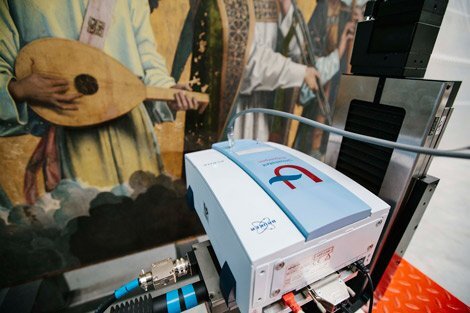By means of macroscopic scanning reflection FTIR spectroscopy, it is possible to record highly specific distribution maps of organic and inorganic compounds from flat, macroscopic objects with cultural heritage value in a non-invasive manner. Our previous work involved the recording of macroscopic distributions of chemical elements or crystal phases from painted works of art based on respectively macroscopic X-ray fluorescence or X-ray diffraction analysis. The use of infrared radiation instead of X-rays has the advantage that more specific information about the nature and distribution of the chemical compounds present can be gathered. This higher imaging specificity represents a clear advantage for the characterization of paintings and artists materials. It allows the distribution of metallo-organic compounds to be visualized and permits to distinguish between pigmented materials containing the same key metal.
The prototype instrument allows to record hyperspectral datacubes by scanning the surface of the artefact in a contactless and sequential single-point measuring mode, while recording the spectrum of reflected infrared radiation. After the acquisition, spectra, line intensities of individual bands and chemical distribution maps can be extracted from the datacube to identify the compounds present and/or to highlight their spatial distribution. Not only is information gained on the surface of the investigated artefacts; also images of overpainted paint layers and if present, the underdrawing, may be revealed in this manner.

Reflection MIR scanning on Hans Memling's 'Christ with singing and music-making Angels'. Collection of the Koninklijk Museum voor Schone kunsten Antwerpen. Photo by Jesse willems.